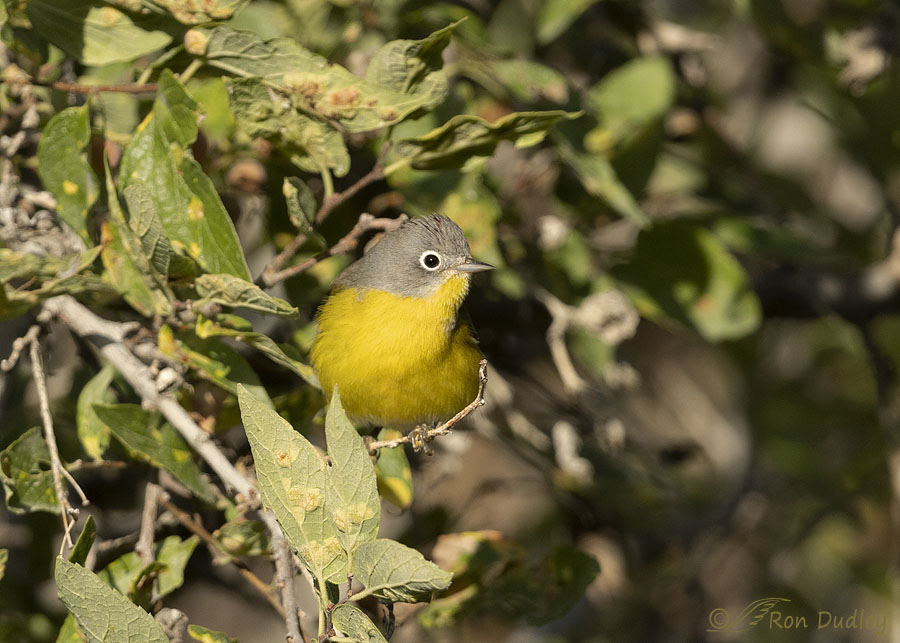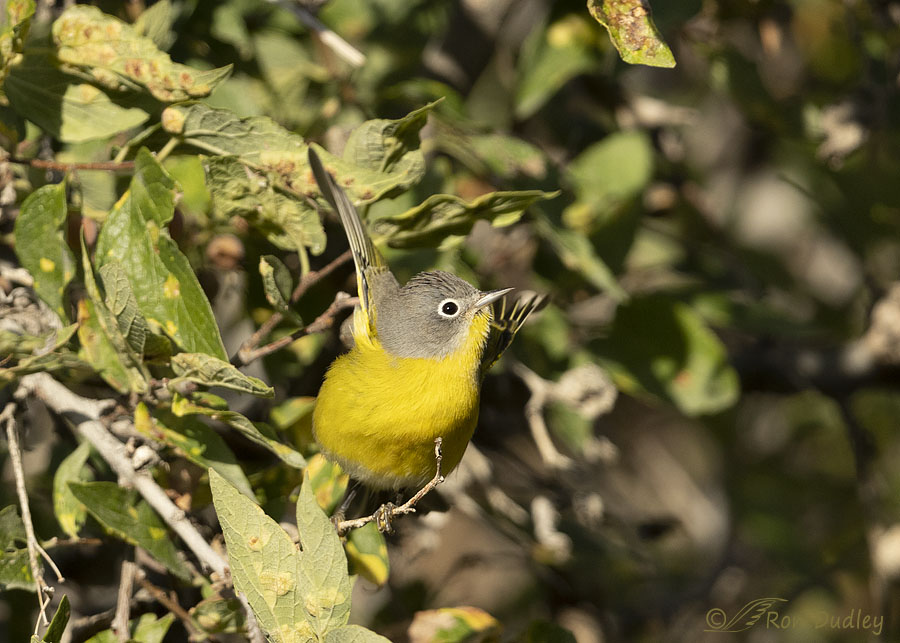I’m finally beginning to see some pretty good numbers of migrating warblers moving through and yesterday morning this male Nashville Warbler was one of them.

1/2500, f/5.6, ISO 800, Canon R5, Canon EF500mm f/4L IS II USM + 1.4 tc, not baited, set up or called in
He didn’t give me much of his time, and he gave me even less pose variety, but I was happy to get him in my viewfinder at all. This is a species I seldom see, seldom enough that in twelve years of blogging I’ve only posted one other photo of a Nashville Warbler.

1/2500, f/5.6, ISO 800, Canon R5, Canon EF500mm f/4L IS II USM + 1.4 tc, not baited, set up or called in
I even caught him at the moment of takeoff. I also got a flight shot of him that I’d have loved if it hadn’t been too soft.
Next time…
Ron
Notes on my post two days ago about amaranth and goldfinches:
- Apparently in that post I misidentified Lesser Goldfinches as American Goldfinches. Two blog followers who seem knowledgeable about goldfinches pointed out my error in the comments. I’ve added a note to that post acknowledging my error.
- After seeing that post, several blog followers were interested in planting amaranth in their yards next year so they asked what variety it is. I don’t know (a friend gave me the original seeds many years ago and they keep volunteering in my garden). Two readers have suggested that the variety is Love Lies Bleeding, but after doing some research I’m skeptical. According to my research Love Lies Bleeding only grows to 5′ tall and has drooping flower clusters but the variety in my garden routinely grows to about 10′ tall and most of its flower clusters remain vertical, or nearly so.


I planted Hopi Red Dye Amaranth in my garden this year, which is a brilliant red/magenta hue and very vigorous. I bought the seed from Botanical Interests, which is a very reliable seed company.
The flight take off is stellar!
Thanks, Arwen.
Great just-about-to-takeoff shot! Happy to see this little ball of sunshine.
Thanks, Marty.
A total charmer. I loved the way it posed for you – however briefly.
Thanks, EC. Briefly indeed. And with little variety but I’ll take it.
Warblers’ of any kind are not birds I’ve often seen, but this is a handsome one, despite its generic name, part of which means “plain”. The BotW map indicates it doesn’t occur here, yet there are a lot of sightings on ebird. Curious.
Thanks to yesterday’s commenters, now I, too, can ID American and Lesser Godfinches. At least in from your photos.
BTW, I’m back on the email list.
“now I, too, can ID American and Lesser Goldfinches”
Lyle, when they’re not in breeding plumage I still have a tough time with them. I’d swear that the birds I photographed were larger than American Goldfinches.
And good, about getting back on the list!
Very nice to see you this morning Ron – love the ring on that warbler’s eye and his beautiful yellow! FYI- the bird feeder project is moving along nicely! Several blue jays are enjoying the new feeder and chase off the house finches that are trying to control both feeders. So entertaining!
Sounds like your strategy is working, Kathleen. I wish I could come up with one that works with House Sparrows. And starlings. And Eurasian Collared Doves.
Beautiful photos! Look at those eye rings! We’ve had just a few different ones moving thru – they are fun/aggravating because they are deep in the trees and so fast – you see these little flashes of yellow and a glimpse of a head which then have to be put together to match something in the Warbler book. That’s why we need masters like you, to get them to STAND STILL!
Ha, I’m far from a master at getting them to stand still, Carolyn. Quite the opposite, I’m convinced that they take me aiming my lens their way as a signal to turn on their afterburners.
Good pose on that first one. Don’t recall having ever seen one myself.
We have lots of goldfinches around here, and for years I was calling them American Goldfinches. Then not too long ago I consulted my field guide (for reasons I cannot recall) and discovered that they were in fact Lesser Goldfinches.
Never much cared for the use of “Lesser” in a name. Sounds like a slight of some kind. I’m sure that it is not what name implies, but to me it sounds that way. Same with “Greater”. Is it really (I say to myself).
“Never much cared for the use of “Lesser” in a name”
You’re far from the only one, Michael. There’s a movement afoot to change the common names of many birds and the reason you mention is one of them.
What a lovely little bird ! I’m glad you received a reward for making what
I’m guessing to be an “effort” these days to go out and do what you love.
May you continue to be rewarded with unusual sightings like these !
Kris, photographing birds is rarely, if ever, an effort for me. What’s problematic right now is finding the time. As you can imagine I have a lot on my plate and I’m not moving very fast these days.
Fall migration is evident down here in Florida as well. Superb shot of the Nashvillel Warbler. I have seen exactly two and have never obtained an image.
Thanks for scooting your colorful birds in our direction.
Ha, I intend to hold on to them for a while before I scoot them your way, Wally!
That is a beautiful photo of the Nashville Warbler. They are not a real common visitor here, but we do get them during transition. I have never knowingly seen one.
Really glad you posted this about the Lesser Goldfinches. I thought they might be Lessers and not American, but just moved on without really checking.
I forget – do you have a surgery date yet?
Everett, my surgery is scheduled for a week from today but that date presumes that all of my blood tests fall into line. If they don’t, things could change.
Cute little Warbler – glad he let you get a few shots!
Golfinches here have moved on as of yesterday – still a few Towhees. Suspect the incoming weather told them to get going tho they’d be fighting the wind from the S – SW. Lots of wind – little rain for us so far.
Whatever the Amaranth is it’s beautiful and the birds sure like it……;)
Thanks, Judy. That amaranth is so much fun to watch while it’s growing because it grows very fast – so fast I can easily see the difference from day to day.
Ahhh, the little birds. Glad you got what is almost a lifer (2nd sighting ever). They certainly do move quickly, always hide in dense bush, and usually take only short-hop flights in an erratic pattern. You were lucky to catch that takeoff, especially with such a busy background which could easily have mucked with the focus. Well done, as usual.
Granny Pat, I think it was the busy background that “mucked” with the focus of the flight shot. Very disappointing because otherwise I’d have loved that shot.